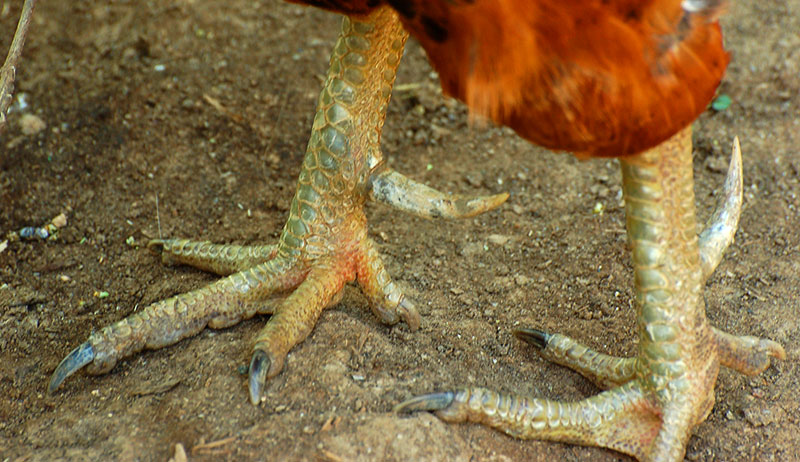
Rooster spur injury and other wounds can happen when working with a chicken flock. Chickens might not have the teeth that other domestic animals do, but they can still cause quite a bit of damage, intentionally and unintentionally. As chicken owners, be prepared to handle any of the following injuries.

Abrasions & Lacerations
Scratches and scrapes are the most common injuries suffered by poultry keepers and can be from a rooster spur injury. Lifting a hen off a nest, moving a bird from or onto a perch, or doing any kind of coop-cleaning or maintenance are instances where your skin can come in contact with your chicken’s talons. Because of the nature of their purpose, for digging and defense, talons are naturally sharp, meaning they can just as easily break human skin as they can the surface of the ground. Given that talons encounter dirt, droppings and other unsanitary surfaces, you should consider a scratch from this source contaminated and treat it accordingly.
While preventing scratches might prove difficult, you can minimize your exposure by wearing long pants, sleeves and gloves while interacting with your flock. You can also reduce the damage your birds’ talons might inflict by inspecting them regularly to check for jagged edges that might trap more grime; these can be trimmed using a pet file or clipper.
Bruises
Although chickens are relatively small animals, larger breeds such as Jersey Giants, Brahmas and Australorps can deliver significant force. The pectoralis and supracoracoideus muscles that control a bird’s flight are extremely strong. One smack from an agitated chicken’s flapping wings can blacken an eye or cheek—or anything—quite easily.
To prevent getting battered, pick up your hen or rooster in a manner that keeps both wings pinned tightly against the bird’s body. Avoid holding your bird anywhere near your face; if you need to examine an injured or sick bird, enlist someone to securely grip your chicken while you examine it.
Puncture Wounds

Descended from the red jungle fowl (Gallus gallus), the domestic chicken comes equipped with two natural weapons that helped it survive in the wild: its spurs. Hens grow only little buds on their feet, but roosters can grow spurs that are extremely long, sharp and dangerous. Spurs are what roosters use against rivals as well as other threats to themselves and their hens. Should one of your boys perceive you as a threat, he will not hesitate to use his spurs against you and this can cause a rooster spur injury.

Because spurs consist of bone covered with a hard keratin sheath, they cannot be cut off without injuring the rooster. You can, however, reduce their size and minimize the potential damage to your flock and to yourself.
Many poultry owners keep an avian first-aid kit handy, stocked with antiseptic, ophthalmologic ointment, veterinary bandages, electrolytes and other items needed to treat an ailing bird. In addition to these items, keep rubbing alcohol, antibacterial ointment, gauze or cotton balls, and bandages on hand for yourself in case you are the one who suffers the barnyard injury. Most importantly, do not hesitate to seek professional medical assistance when your wound is severe, as I did after Davey sank his spurs into me.
This article about rooster spur injury and chicken wounds was written for Hobby Farms and Chickens magazines. Click here to subscribe.




